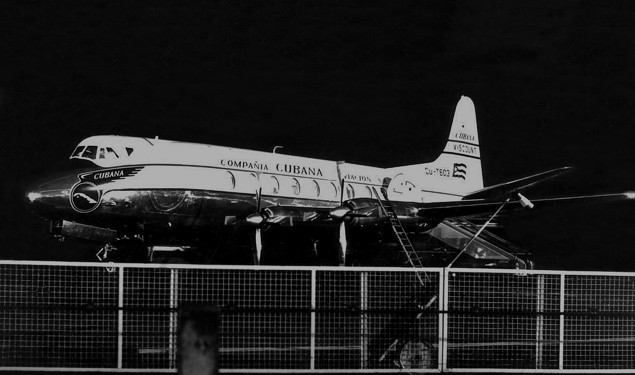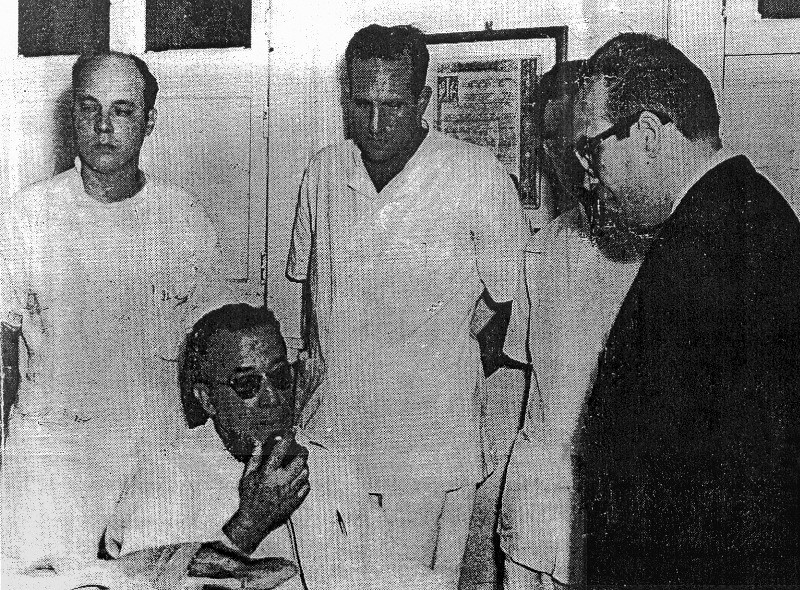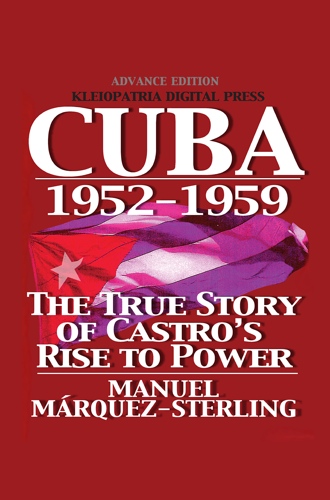November 1, 1958
In the Fall of 1958 Fidel Castro invented a terrorist tactic that would endure. Castro’s sinister advance in terrorism introduced the world to political hijackings of international commercial airliners. Unlike earlier commandeering of commercial aircraft as a means of travel for the desperate, or cash for criminals taking hostages and property to ransom, Castro’s rebels pioneered a new kind of hijacking aimed at obtaining publicity and political gains.
The most notorious of the 1958 hijackings took place on November 1, 1958: Cubana Flight 495 from Miami to Varadero, a Vickers Viscount 755D four-engine turboprop airplane. Minutes before landing, five passengers drew firearms announcing they were Castro rebels and were seizing the aircraft.
Holding the passengers and cabin crew at gunpoint, Castro’s hijackers pulled up the aircraft carpet and opened a hatch to retrieve 26th of July Movement uniforms and military gear stowed in a sub-floor compartment. In full view of the passengers, the rebels stripped to their underwear and donned olive green rebel uniforms complete with M-26-7 black and red armbands. Two of them broke into the cockpit and ordered Captain Ruskin Medrano Portuondo and First Officer José Combarro to take the plane to a small airstrip near the Sierra Cristal. There was a row in the cockpit; when Captain Medrano argued a Viscount could not land at a small airstrip, he was pistol-whipped. There have been conflicting accounts about who flew the airplane after that. Some claimed a hijacker with flight training, Edmundo Ponce de León, seized the controls. However divers who recovered passenger remains reported Capt. Medrano’s body was recovered from the pilot’s seat, indicating he was at the controls at end of the flight.
The rebels were smuggling a shipment of arms, grenades, and military supplies for delivery to Raúl Castro’s headquarters in the Sierra Cristal. The bold rebel plan was ill-conceived. Among the weaknesses of the plan was the landing area chosen. In addition to selecting an airstrip where it was impossible to land a Viscount, there were no nearby airports suitable for a plane of its weight and speed. Even the largest airport nearby, the paved but short runway at Preston (a United Fruit Company sugar mill) could not accommodate aircraft larger than a DC-3. Under the best of circumstances, a Viscount forced landing at Preston would have been a controlled crash resulting in significant damage and injuries. These circumstances were far from the best: low on fuel, no radio contact, and night operations in darkness (the airfield at Preston had neither radio communications nor runway lighting).
After apparently making a number of aborted landing approaches in the Mayari area, the Viscount attempted to land at Preston. On approach to Preston a hijacker exited the cockpit and taking a seat at the back told the passengers to brace for a crash because they were out of fuel. Instants later the Viscount crashed into the dark waters of Nipe Bay, at about 9:00 PM.
The Director of Preston Hospital, Dr. Octavio Ortiz Padró, rapidly set up emergency facilities for victims of the disaster. But only three survivors were rescued: Osiris Martinez (whose American wife and their three infant children perished in the crash), Omara González and her young cousin Luis Sosa (both traveling with their grandfather, who did not survive). Ten passengers (seven of them Americans) and the entire crew of four perished.
Though contemporaneous news accounts indicated there had been 17 fatalities, it was subsequently discovered that three of the hijackers never found and presumed dead were actually rescued by Castro’s rebels, two quickly ascending through the ranks. Edmundo Ponce de León was promoted to Lieutenant and two months later was assigned to a police station as second in command. The other, Manuel Fernández Falcon, rose to become Chief of the Counterintelligence Directorate at the Interior Ministry.
Remarkably, in 1994 hijacker Ponce de León sought and was granted admission to the US as a naturalized citizen. In a strange twist of fate, he lived near the two surviving passengers of the Viscount crash until his death in October of 2011.
Cubana Airlines pilot Captain Armando Piedra was thrice touched in three weeks by Castro’s pioneering air terror campaign. The week before the Viscount hijacking he had been the pilot of a Cubana Airlines DC-3 hijacked by Castro’s rebels at gunpoint. An experienced scuba diver, Piedra volunteered to assist search and recovery operations in the shark-infested waters of Nipe Bay where the Cubana Viscount hull finally came to rest. He had the burdensome task of unharnessing and removing the body of his friend and colleague Capt. Medrano from the pilot’s seat. A few days later he would be the pilot in command of yet another Cubana DC-3 hijacked by armed rebels. The hijacked DC-3 passengers and crew were taken hostage and used as bargaining chips to force compliance with Castro’s financial and political demands. One of the hostage passengers was the son of General Eulogio Cantillo, commander of Batista forces fighting rebel strongholds in Oriente. The rebels appropriated the two aircraft which they deployed in support of their insurgency operations.
based on Manuel Márquez-Sterling's Cuba 1952-1959 and
Cuba 1952-1959 Interactive Timeline
Cuba 1952-1959 Interactive Timeline






 Mobile subscription
Mobile subscription



No comments:
Post a Comment